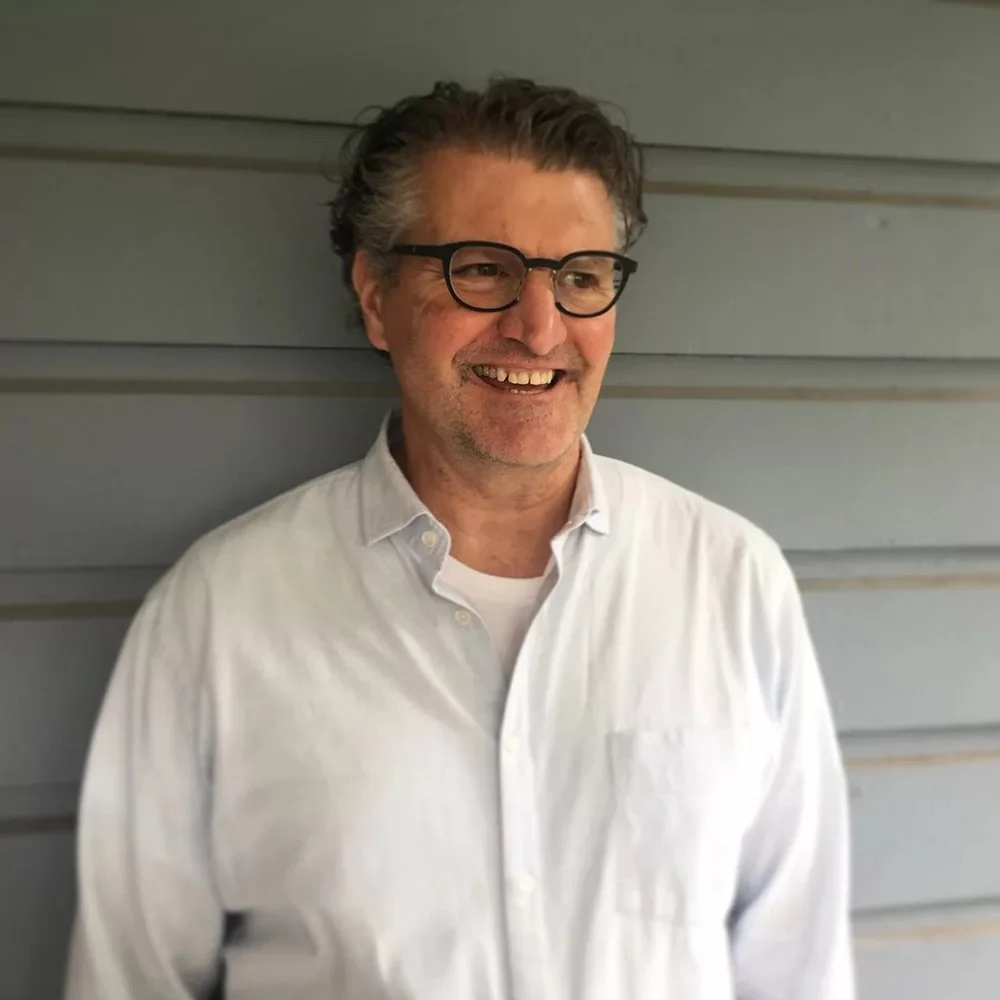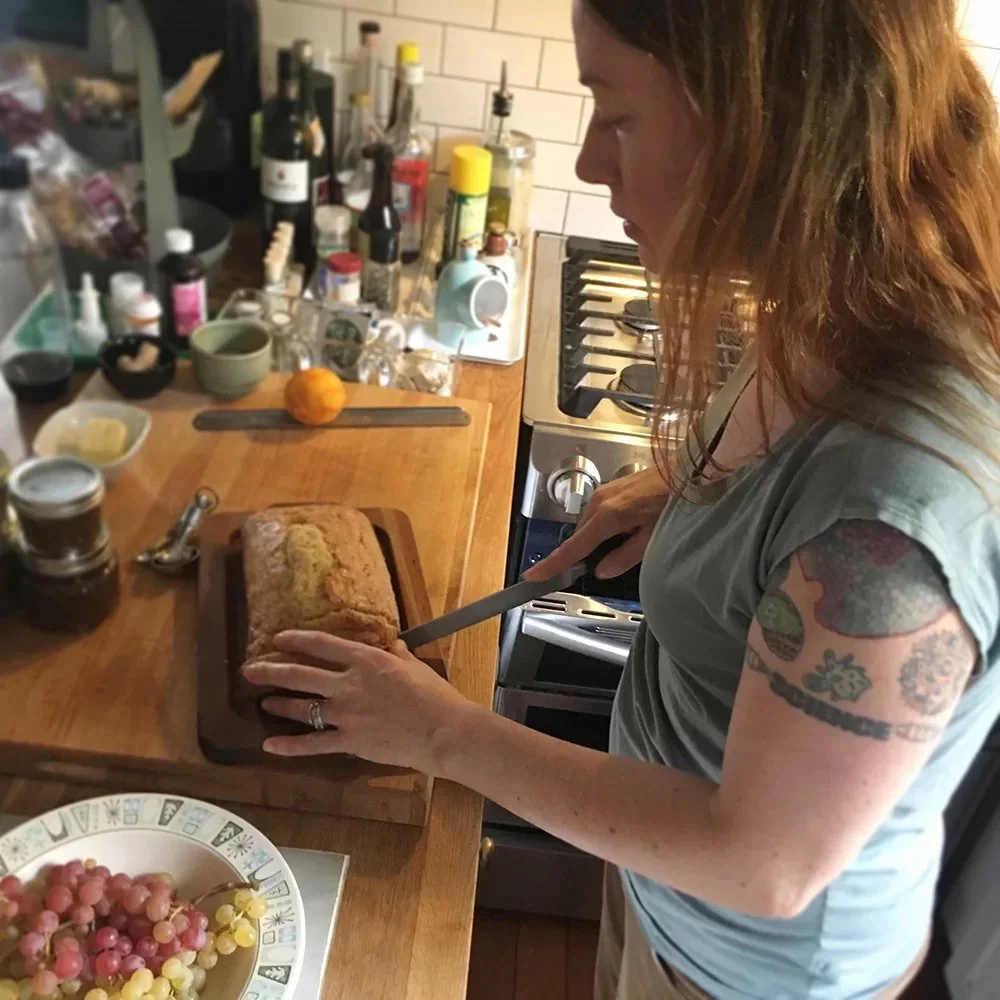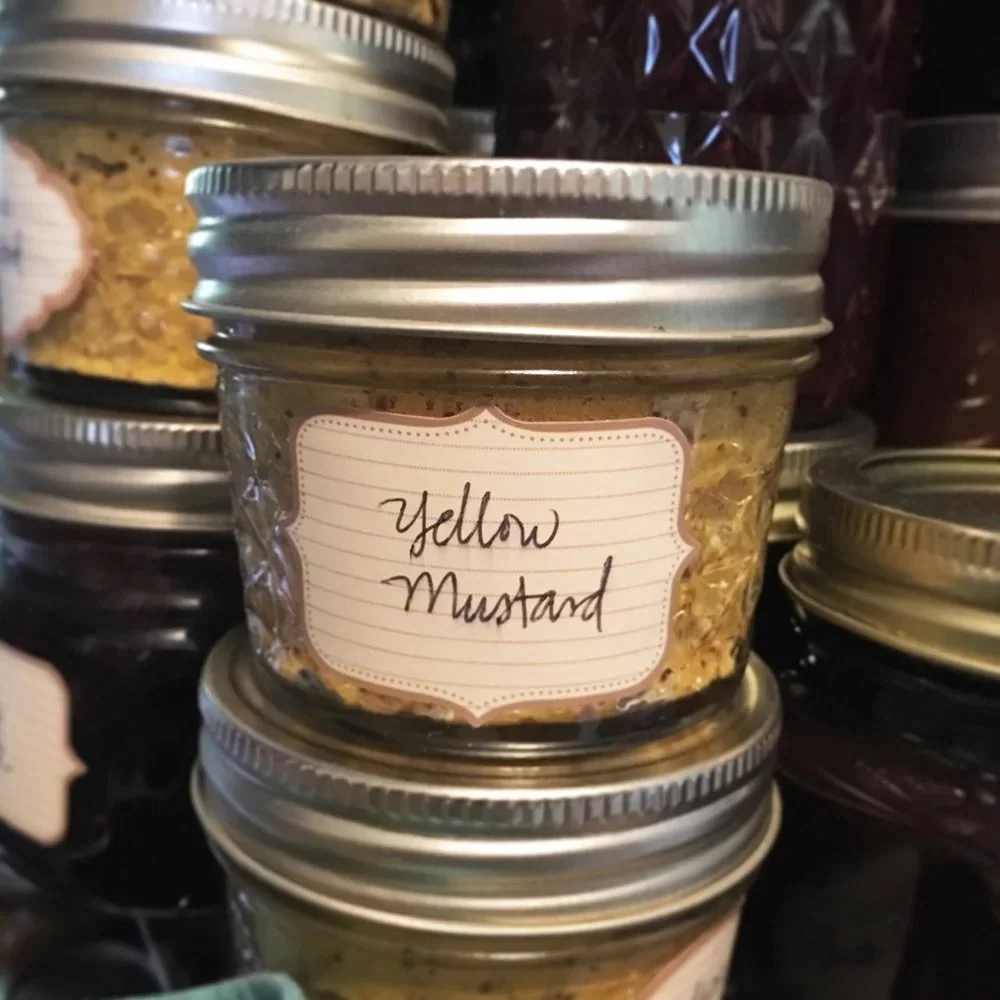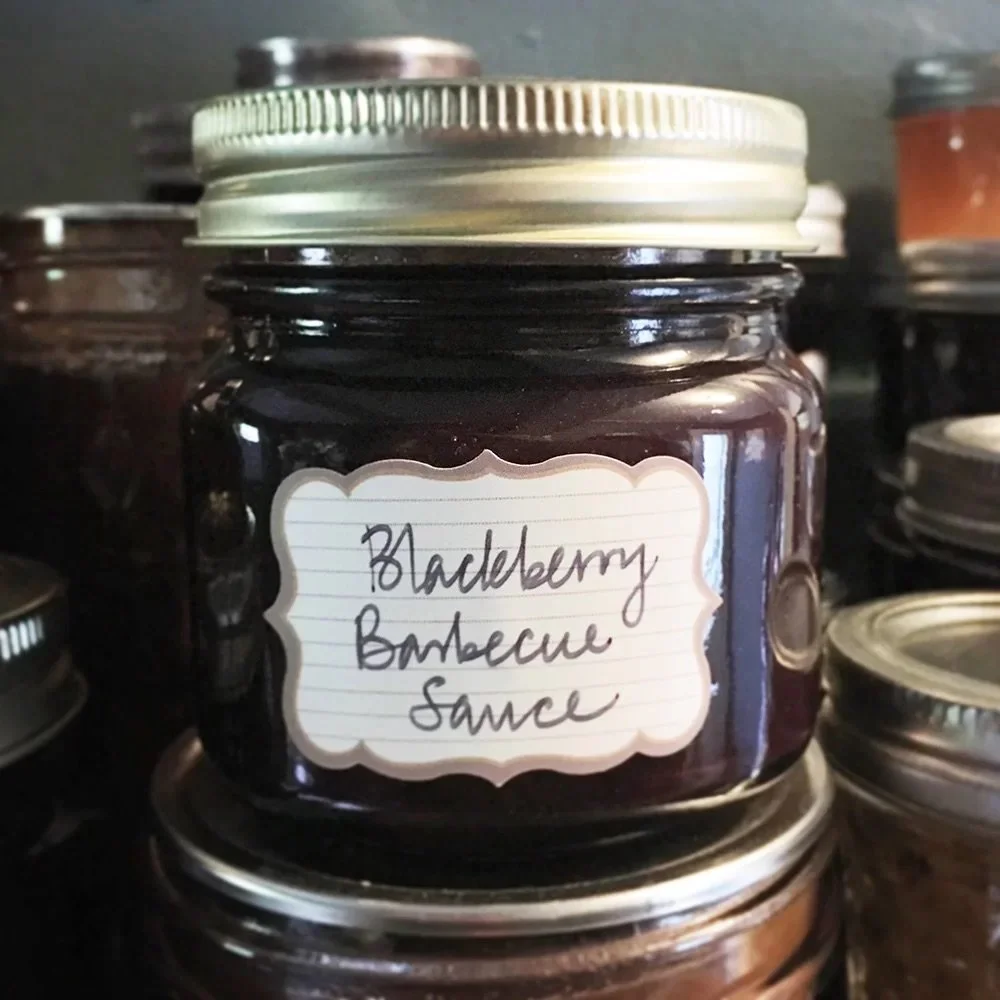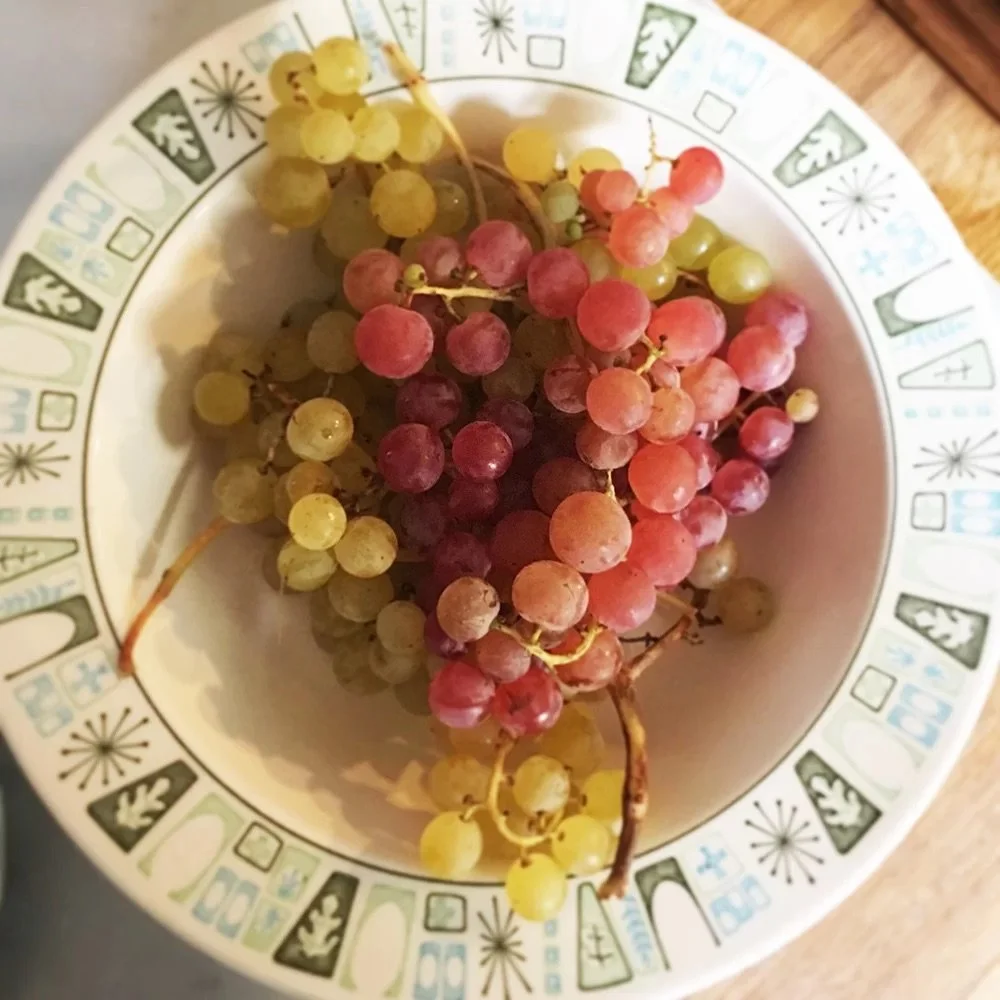CULTIVATING THE CUISINE OF THE PACIFIC NW
INTERVIEW WITH CORY SCHREIBER
IN THE SPRING OF 2018, contributing writer, journalist, and food historian Heather Arndt-Anderson and publisher Brett Warnock sat down at Brett’s place for coffee talk with legendary Portland chef, Cory Schreiber, including his time cultivating the cuisine at Wildwood Restaurant. The conversation was recorded by Sam Cole, and the story edited and written by Erin Hampton. Photos were taken by Brett a couple months later at Heather’s home in SE Portland.
James Beard Award-winning chef Cory Schreiber.
SHIPWRECKED IN THE OYSTER TRADE
CORY SCHREIBER’S PACIFIC NORTHWEST CULINARY JOURNEY began before he was even born; it all started with his great-great-grandfather, Meinert Wachsmuth, who left the Isle of Sylt, an island off of present-day Germany, in the 1850’s to see the world. After sailing seven times around the Horn, he shipwrecked at Yaquina Bay, OR, where he discovered an abundance of oysters and began a career in the oyster trade.
“What was growing wild was oysters,” says Schreiber, “and so it seemed a natural fit to begin harvesting them. So then began the business of cultivation.” Meinert began shipping the oysters up and down the West Coast, a trade that proved lucrative during the Gold Rush of the 1860’s. Eventually, Meinert, his wife and their four sons migrated to Portland, but they didn’t leave their oyster cultivation behind. In 1907, Louis C., Meinert’s son and Schreiber’s great-grandfather, opened what he called “Louie’s Oyster Bar.”
My great-grandfather’s theory was that you cut out the middleman, right?” says Schreiber. Louis C. realized that, beyond simply serving oysters at Dan & Louis Oyster Bar, the family could grow the oysters themselves. Schreiber’s great-grandfather educated himself locally with the help of other oyster cultivators, but his real skill was navigating the restaurant business.
Schreiber says, “If you look at the photographs of him, he’s wearing a three-piece suit out in the mud with his pants rolled up. I don’t think he wanted the reputation of being the ‘oyster man’; he wanted to be the “businessman.” It’s what he was, and successfully so.” As the years went on, Louis C. created a booming restaurant, which he continued to pass down through the generations.
Louis C. groomed his youngest son, Dan, to take over the restaurant, but when Dan passed away at age twenty-seven, the family renamed the restaurant “Dan & Louis Oyster Bar,” as a memorial to his son. In his place, Louis A., another one of Louis C.’s sons, started learning more about the business. “Louis A. Wachsmuth was my grandfather, my mother’s father, and he took it over,” Schreiber says. “He was running it strong and firm by the time I started working there in 1972, when I was eleven years old.”
IN THE DISH ROOM CUSSING LIKE A SAILOR
“I GOT TO GO INTO THE DISH ROOM AND JUST TURN THE HEAT UP AND START SWEATIN’ AND CUSSING LIKE A SAILOR, and drinking more Coca Cola that any kid should be allowed,” says Schreiber. “I also thought the payment system was brilliant in the beginning because I was paid a dollar an hour…I was buying guitars and amplifiers, and I thought I was going to be the next Robert Plant.”
“OBVIOUSLY, I STAYED IN THE DISH ROOM.”
Besides a brief stint in retail as a teenager, and a desire to try out forestry, Schreiber has been in the restaurant business all his life. The food world just kept pulling him back. When he was 17, Schreiber “shot right back to the bottom” and got a job at Taco Man, a local fast food joint in Portland.
“They would throw a fifty-pound sack of beans on the counter, and the owner told us to find the rocks it,” Schreiber notes with a chuckle. “Great job. That’s an important step, I think, for anybody. I tell kids in culinary school that with fast food, you learn a lot.”
Then, Schreiber got a job as a busboy at the London Grill in the downtown Portland Benson Hotel, where the impact of history and immigration of the PNW food scene dawned on him. “I was one of the few caucasian fellows down in the London Grill; the bussing staff was mainly from the Middle East—there were Saudis, there were Kuwaitis, there were Lebanese— and then the wait staff and the captain area was mostly African-Americans. It was a very different culture. And, at the door, the Maître D’ was always a German.”
Heather Arnt-Anderson, a Portland local whose family, along with the Schreiber family, traces their lineage back to the Volga Germans, has researched the impact of immigration on the food scene in Portland. She notes that, specifically with German heritage in Portland, “there’s just an old-school conservatism with the way wealth is displayed, and with the way wealth is passed down generationally, and so I think a lot of that German culture informed Portland’s wealth culture for a really long time. There was that ‘Wild West’ independence that I think caused a lot of people to behave more carefully.”
Schriber notes that, back then, “You did not show money in this town. Everybody kind of kept their money stashed up somewhere in the hills and just didn’t show it when they came downtown. So, the London Grill was this dark restaurant where you just still didn’t show nice bottles of wine and stuff.”
After his four-year apprenticeship in the London Grill, where he combined the knowledge he gained growing up in Dan & Louis’ with the strict, humbling European-run environment, Schreiber was ready to leave Portland and experience the culinary arts on a wider scale.
He spent his next thirteen years working in hotels and restaurants in San Francisco, Boston and Chicago, where he did everything from run rotary stoves for 1,000-person banquets to working a room-service graveyard shift. “Really, the learning curve was out there in San Francisco and Boston and Chicago,” he notes. “It’s just kind of the survivalist mode of working in those hardcore, tiny, hot kitchens, where it’s just brutal.”
Schrieber learned from working in hotels, but after a while, he made his way back into the freestanding restaurant world. “When you come from a freestanding restaurant, you eventually work your way back to a freestanding restaurant,” he notes. He worked his way through hotels in Boston, then took restaurant jobs in Chicago and San Francisco, working his way across the food capitals of the country. “Those were all honing grounds,” reflects Schreiber, “but I think San Francisco’s the Mecca. I think really when you talk about food and wine and cultural impact, you’ve got to spend time there. But all roads did definitely lead back to Portland, without question.”
Heather in her kitchen slicing homemade bread.
THE CULINARY ROAD BACK TO PORTLAND
SCHREIBER COULDN’T STAY AWAY FROM HIS CULINARY ROOTS FOREVER. After years learning from cooking prodigies around the US, Schreiber’s culinary road led him back to Portland. And he realized that Portland wasn’t the same “godforsaken stump town” he’d left behind.
“When I came back home, it just hits me like a ton of bricks,” Schreiber remembers. “I’m like, ‘Wow. This town is now ready to show money on the food and wine tables.’” Before he left, Schreiber estimates that the average check at the oyster bar was $3.50 per person, including fish & chips, a cup of coffee and a slice of cheesecake. But upon his return, he saw that the food scene in Portland was growing beyond what he expected.
Born and raised in the Pacific Northwest, Schreiber also realized that the Portland culinary environment had access to something unique; fresh, locally-sourced food. Schreiber wanted to bring together his family’s background in the restaurant and cultivation businesses with his knowledge acquired from America’s cultural and culinary epicenters. He says, “I don’t like the words ‘my food.’ Coming back to Portland, you would never say that, and that goes back to the German ancestry, too. We’re focusing on cultivating the cuisine of the Pacific Northwest.”
Arnt-Anderson adds, “Let’s face it; you’re cooking your dad’s food, or you’re cooking your grandmother’s food. You weren’t cooking your own food, because those restaurants are all passed down through generations.”
Schreiber agrees. “You just kind of update the playbook, I like to say. The recipe playbook, if you will, and you respond to the marketplace.” When he re-entered the Portland food scene, he saw that what the marketplace needed was a fusion between big-city trends and the unique abundance of fresh food the PNW had to offer. “I think you kind of had to be from here to really understand it,” he reflects.
Without a doubt, Schreiber understood it. With that understanding, he created Wildwood, a gathering place for community members, a hub for a farm-to-table mentality, long before the movement began.
Homemade yellow mustard in Heather’s well-stocked pantry.
A FARM-TO-TABLE MENTALITY
“THE FIRST THING I DID WITH THE LAST PENNY I HAD AFTER I MOVED BACK, was I went and bought a truck,” says Schreiber. At the time, purveyors were incredulous; unfamiliar with Schreiber’s farm-to-table mentality. “Eventually,” he notes, “What I heard from purveyors later on was, “Oh, he’s serious. He wants to see where the stuff is coming from. He wants to see what my plant looks like.”
Schreiber wanted to make sure and feature locally-sourced meals, though this idea morphed into constant change and growth over the restaurant’s lifetime. “I love the idea of having a vision,” he says, “and then manifesting it into a physical thing. It’s never what you think it’s going to be, and I think that was a very interesting thing about Portland at that time, with a restaurant like Wildwood. I think, in my case, it also goes back to my great-grandfather growing oysters. I think that is a DNA-charted thing in me, like, ‘Oh, go get it yourself.’”
Schreiber wanted to send a message to both his distributors and his customers that he was serious about how and where he sourced his food. “Ultimately,” Schreiber says, “that became the farms. Really, if you asked what the vision was, we wanted to support farms, local farms. That was the most gratifying thing, to write checks to farms. If you ask me personally, it was sending money in the right direction.”
Schreiber and similarly-minded chefs in the area, like Greg Higgins (Higgins), Vitaly Paley (Paley’s Place), and Phillipe Boulot (Heathman) were all cultivating from the same farms, trying to encourage a boom in growth and cultivation, though Schreiber never asked the farmers to grow specific foods; he worked seasonally, relying on the farmers’ crop expertise and loyal customers to get them through the gloomy Portland winters.
One of the questions Schreiber returned to was, where was the public most responsive? “Did people say they loved the summer food,” he asks, “but were never going to eat here in January? We used to estimate that our core group of regular customers that we shared, with Vitaly and Greg and Phillipe and other people, was probably like 4,500 or 5,000 people. it was a pretty small pod of people that we relied on in January and February to get us through the winter months.” But he and the other local chefs were able to continue to bring people in and make their restaurants grow.
Part of the boom in Portland’s food scene at the time could be from the attention that Anthony Bourdain, Sunset Magazine, and the New York Times brought in the late 1990’s and early 2000’s, and part of it could be that a lot of the chefs like him had taken the time to leave Portland and learn about the trends and styles of restaurants in larger cities like San Francisco and New York. “I think some of the stories that we got traveling around the United States and brought back to Portland helped the craft,” Schreiber says. “You know, I’d go to a restaurant, notice things about service, like how they held the silverware and what kind of box. It continually changed the restaurant.”
“For me,” he adds, “It had to be a work in motion. There was no way that it was going to become stagnant. ‘I’m not going to let you look back. That does not exist anymore. Right here, there’s only one way for us to look forward.’ That was part of my theory and practice.”
Arnt-Anderson adds, “If you are in a town like Portland, which is inhabited primarily by people who didn’t grow up here, there’s always going to be an injection of fresh blood in your kitchen, and that I think is a key to staying in motion, and constantly evolving. If everybody was just still from Portland, and we’re all just old-guard restaurant people, there would never be any change.”
Part of Schreiber’s success stems from finding inspiration from the people around him. “I’m amazed that people don’t populate their businesses with people that want to stimulate them and inspire them,” he says. That’s exactly what he did with Wildwood; he incorporated people who brought new ideas to the table, including chefs like Adam Sappington, Brad Root and Jen Lewis, along with bartenders from the restaurant that are now mixologists. Schreiber notes, “They were just in sync with the ethos that we were practicing, in terms of the food and where it came from.”
Instead of accepting stagnancy in their kitchen, Schreiber and his staff constantly sought change within the walls of Wildwood and far beyond. “I was free to go and craft, you know, underneath the guidelines of the foundations of cooking,” says Schreiber. “At the restaurant, we did have that classical foundation, because that’s what I brought to the table to give it structure. But I think after that it became an incubator. I was always actually, quite frankly, terrified that I would become stagnant. That scares me more than anything.”
“THERE ARE SO MANY WAYS THAT WE CAN SEE FAILURE IN OURSELVES,” notes Arndt-Anderson. “I think that’s a really good way to see it. Just change, evolve, or die.”
Homemade blackberry BBQ sauce in Heather’s well-stocked pantry.
DEEP KNOWLEDGE AND CONSIDERABLE EXPERIENCE
SCHREIBER CHANGED AND EVOLVED WITH WILDWOOD UNTIL HE LEFT THE RESTAURANT IN 2007 when sous chef Dustin Clark took over as executive chef until the restaurant closed its doors for good in 2014. Schreiber went on to apply his deep knowledge and considerable experience with local, seasonal food as the Oregon Department of Agriculture’s Farm-to-School Program Manager. In January 2010, Cory joined the faculty of the Art Institute of Portland as its “culinary artist in residence,” a post he held until 2016. During his time there, Cory brought a contemporary focus to seasonal cooking, with an emphasis on sourcing and preparing high-quality ingredients.
Now, Schreiber brings this extensive expertise to the largest food distributor in North America, Sysco. His ‘think-tank’ mentality throughout his career has enabled him to transfer the importance of sustainability within food systems to a larger, corporate model.
Schreiber estimates that he works with about two hundred clients a year doing menu analysis and recipe development for restaurants and businesses. That translates to nearly fourteen thousand food products sitting in his Sysco kitchen at all times, all of which Schreiber can use to help restaurants cater to their customers, while also trying to focus on responsible sourcing.
“It’s a large corporation that has its mission and its shareholders to answer to,” says Schreiber. “It’s interesting for me to come from a small, independent model where I’ve been able to speak pretty loudly, and now to be in a very large model and trying to find voice within that, so we can educate people.”
Part of that education, Schreiber and Arndt-Anderson agree, needs to involve creating more sustainable practices in the food industry, especially in large corporations like Sysco. “In the larger models, you know, for distribution and for growing and transportation, we’ve made plenty of carbon footprint mistakes,” notes Schreiber. “Hopefully, these smaller models mirror or learn from larger models that have made mistakes.”
In his new role at Sysco, Schreiber wants to decrease those mistakes as much as possible. “I like to think, now working in a larger model, that some of the change can come from within,” he says. “People that maybe have my perspective working for a large company could begin to influence from what I call the ‘belly of the beast,’ which is a good place to be if you’re confident enough. If you really want to make these opinions evident and start to maybe move the model.”
Part of Schreiber’s work in changing the larger models involves bringing small vendors into the mix at Sysco. He notes that it’s important to work seasonally, buying from farms and family-owned vendors all over the state, whether it’s “local, small ketchups or barbecue sauces, or cheeses out of the Oregon coast.” Schreiber acknowledges, “It’s not what the company is known for, but I’m certainly out there voicing that the food is everything.”
Along with advocating for these smaller vendors, Schreiber wants to make sure that all individuals involved in food systems are educated on the real price of sourcing local food. “You know, you get into the debts system, and into the government subsidies and throwing food away. We can see it locally, as long as we can afford to pay for it. But that’s another issue, in terms of what it costs, you know, to really pay for real food.”
A piece of this equation involves ensuring that the folks who open and run restaurants have the resources and knowledge to succeed. He says, “we don’t we don’t want to see 176 restaurants open and 76 of them close. We want to try to stop that, and even at times maybe talk people out of it. People spend a million bucks to get open, and it all washes away. I’ve done that. I’ve seen the back side of it, and I think you if we can avoid that, maybe that money gets channeled into other things. Maybe it’s smaller models, creation of a Food Act, or preservation of certain foods.”
Arnt-Anderson notes, that perhaps one reason that so many restaurants end up closing is due to hyper-focus on marketing without aligning with the relaxed, authentic air Portland values. “I think that people want to see restaurants that come into town respectfully and quietly and pay their dues before they blow up,” she says.
Schreiber adds, “Staying on message too, is the thing. I think people start responding to what is going on in the marketplace, and they’re not always thinking about keeping the line with what they intended to do, and in telling that story over and over and over again. That’s really important.”
One of the trends that Schreiber and Arndt-Anderson have noticed in the food industry is the rise of “fast casual” restaurant chains.
“This fast casual is a response to the economic model that exists, that restaurateurs don’t have that much control over, what the legislature says the minimum wage is going to be, or how the cost of food is going up for various regions,” Schreiber says. “They put out high-quality stuff with not many choices, which is good for kids, millennials and for an aging population. That’s what I would do. I’d have to use that model to have this restaurant industry make any sense.”
Perhaps this form of convenient dining stems from another part of the problem with the larger food system: the overwhelming nature of shopping for food in the midst of large, corporate food models.
“You see the looks on peoples’ faces when they go into the grocery store; they are border-line frantic,” notes Schreiber. “It’s like, how quick can people get it over with; it’s a painful experience. I think that we have a huge problem in that. I think maybe the question should be reframed: Where could they go and have an enjoyable experience? You know, where could they really slow down and make good choices and identify where the food is coming from? The answer there is obvious; it’s the 9-5 farmers markets in the state of Oregon. You know, there’s like 35 of them right here in the metro area; that’s the way to do it. The biggest thing we can do as consumers is try not to get beat up and try not to get taken advantage of and really try to ground yourself.”
Schreiber thinks the time for informed empathetic consumers might be coming, and in fact, might have been a part of Oregon’s history all along; “Oregon is really fascinating in terms of what is available for people that live here,” he notes. “I think they should really tap into supporting that as much as they can and defy the other models that are larger and creeping in to take over. That’s where the investment has to go. I don’t care whether you cook or not, or buy the food and hang it on the wall and look at it. Just as long as you buy the food and do something with it. That’s what it’s really always been.”
Fresh grapes on the kitchen table.
COOKING AT HOME
SCHREIBER AND ARNDT-ANDERSON have both brought this idea of local food sourcing from their workspaces into their homes. Kitchen Table Magazine wanted to learn a little bit more about their perspectives on the intricacies of cooking at home. Arndt-Anderson enlightened us about what she calls “hobby shopping,” where, instead of spending money on shoes or clothes, she buys ingredients. And with them, she makes magic.
“It’s affordable tourism for me,” says Arndt-Anderson. “I just kind of, like, hoard ingredients and then I experiment with them. Like, ‘Oh, I can use this Indian spice in an Italian or Western-style cooking.’ That’s going to bring a totally different component to a dish that is usually just French or Italian. So, that’s just the way I like to experiment.”
Schreiber adds, “I do agree with Heather 100%; it’s ingredient-driven…Cooking is components, and understanding components. I mean, sometimes you can get down to technique, and you can live off four techniques; you can live off steaming, pan searing, roasting and, I don’t know, grilling. I mean you really could just learn four techniques, but the ingredient thing is going to go on forever. I love those types of exploration, and that’s really what cooking is; it’s just an exploration. I think most chefs would tell you, ‘The passion is in the ingredients.’”
So, if the passion is in the ingredients, as Schreiber and Arndt-Anderson say, what’s the best way to source these ingredients? Arndt-Anderson makes sure to buy meat from her local neighborhood butcher, and she uses every part of the animal to encourage sustainable, waste-preventative cooking. Both Schreiber and Arndt-Anderson shop locally, whether through farmer’s markets or local food distributors. Of course, Schreiber can trace his awareness of food sourcing back to his early childhood, when he first started out in a restaurant.
Schreiber, who now has both a son and daughter working in the food industry, says that passion for food “doesn’t really get out of your DNA.”

